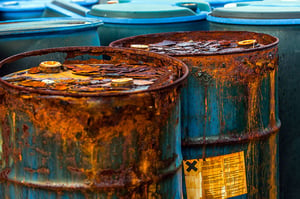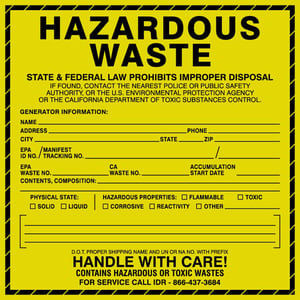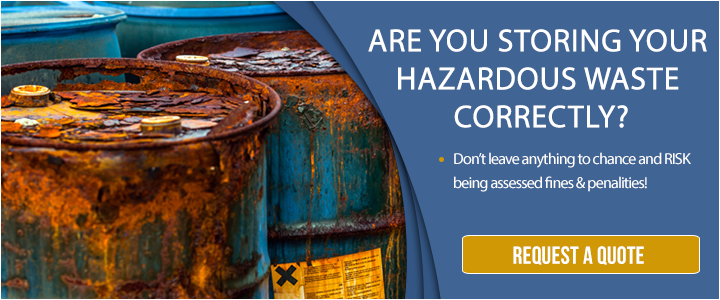Hazardous waste must be disposed of in an appropriate hazardous waste storage container to protect workers, the environment and your business from getting fined.
Proper disposal requires you to understand which materials are toxic, what they do, the types of containers needed for storing the material and the type of personal protective equipment (PPE) that must be used. Here are some essential points to remember about determining how to handle industrial waste.
Know Your Waste
 The type of hazardous waste you generate impacts the type of storage container you use. For example, only containers approved by the Occupational Safety and Health Administration (OSHA) may store flammable liquids. Depending on the chemical, container materials include metal, plastic or glass.
The type of hazardous waste you generate impacts the type of storage container you use. For example, only containers approved by the Occupational Safety and Health Administration (OSHA) may store flammable liquids. Depending on the chemical, container materials include metal, plastic or glass.
In general, metal is most widely used unless metal can adversely affect the container’s contents or the container’s contents could erode the metal.
Medical waste, on the other hand, has a whole other set of requirements when it comes to choosing the right hazardous waste storage container. Containers should be able to resist punctures and leaks and stand up to fire damage, tumbling over and tampering. With medical waste containers, it’s important to consider a container’s compatibility with OSHA’s Bloodborne Pathogen Standard, among other regulations.
Keep in mind also that the color of your storage container also plays an important role in medical waste. While most colors are not regulated at the federal level (red for biohazardous waste and sharps being the exception), it’s industry practice to use a yellow container for chemotherapy waste, black for P-listed drugs and blue for non-RCRA pharmaceutical wastes.
One final note: Another critical reason to know your waste is so that you know which types of waste cannot be stored together in the same container. For example, certain types of solvents are incompatible with materials such as oxidizers. Incompatible chemicals can create an explosive situation. These solvents will require specific procedures for their proper handling and storage.
Determine Amount Of Waste
Choosing the right container size is also important. For example, the state of California requires that any company storing a flammable liquid on its premises must follow the appropriate guidelines for container size.
A glass container, for instance, can hold 1 pint of a Class IA liquid. However, a glass container can hold 1 gallon of a Class II liquid. Our article, What Is The Primary Hazard Associated With Flammable Liquids further breaks down this classification system.
Approved containers and portable tanks that these hazardous materials arrive in from a supplier are acceptable even if they do not meet size requirements and as long as they are compliant with U.S. Department of Transportation (DOT) requirements.
Don’t Forget Labels
 An important part of choosing your hazardous waste storage container also involves choosing the right label that must be placed on the containers.
An important part of choosing your hazardous waste storage container also involves choosing the right label that must be placed on the containers.
Before a container is placed in storage, it must include proper labeling. And, making one or getting one from your local office supply store simply won’t cut it.
RCRA regulations dictate that containers must include proper labeling, marking and placarding. The California Department of Toxic Substances Control (DTSC) also enforces its own set of labeling requirements. For example, hazardous waste labels must include:
- The composition and physical state of the waste
- A statement that calls attention to the hazardous properties of the waste
- Name and address of the generator
- The date when accumulation began
You can read more about these rules in our article, How To Properly Label Hazardous Waste Containers.
A material safety data sheet (MSDS) can also help indicate how materials react and whether or not they post any risk of fire or explosion. Manufacturers are required in many countries to include this information with the product so that employers can pass the warnings onto workers who handle the materials. In the United States, MSDS was replaced with safety data sheets (SDS) in 2013. SDS provides data on chemicals, how they are to be mixed together and potential hazards to workers and the environment.
All containers that store harmful materials must be marked with the words "hazardous waste.” The Department of Transportation has additional requirements for such containers that are shipped offsite.
Other Storage Tips
In addition to the information outlined above, here are a few additional suggestions from the EPA that can help you determine which hazardous waste storage container is right for your waste.
- Corrosive waste should be placed in plastic instead of steel drums, unless the steel is lined with plastic. Steel can corrode, causing drum leaks.
- A corrosion resistance guide can help you determine if waste and drum material are compatible.
- Study the production process to account for changes that may alter the composition of the generated waste.
- Pay attention to temperature fluctuations of the material, as certain chemicals can expand when heated. This can impact how much waste can be added to a container and your overall size of container.
- Frequently reused containers should be assigned specific materials.
Choose The Right Partner
Managing your hazardous waste streams can be challenging and time-consuming. Staying current on storage regulations and ensuring that your protocols comply is all part of the process.
Many companies that generate hazardous waste find value in working with an experienced hazardous waste disposal company that not only will help you properly store and dispose of your waste, but will help you identify it.
Look for a hazardous waste disposal company that:
- Specializes or is knowledgeable in the type of hazardous waste you are storing
- Identifies waste through sampling and testing
- Prepares labels, manifests and other important items that must be included on or with the storage containers
- Offers prompt pickup when containers must be moved from storage to disposal
Working with a certified hazardous waste disposal company to manage your company’s waste will help ensure you follow all regulations and help you manage all of your storage needs.


Comment